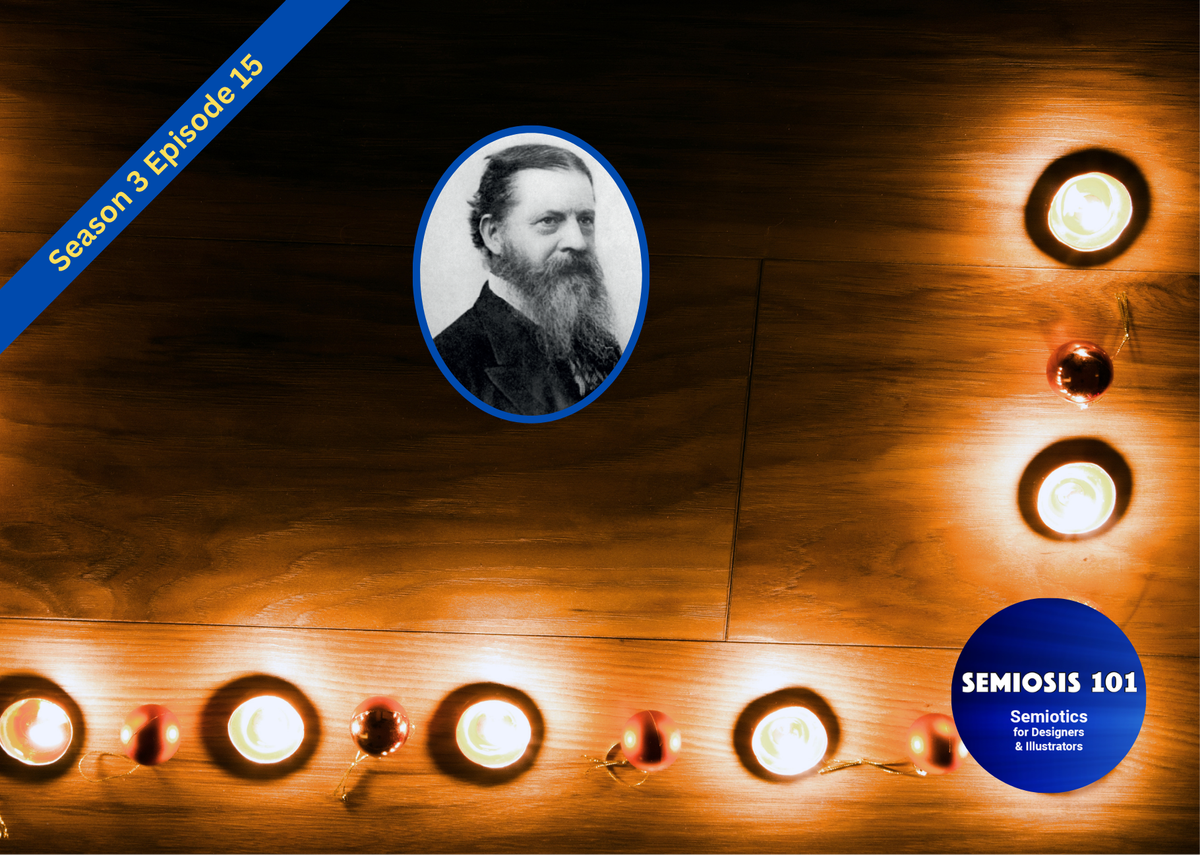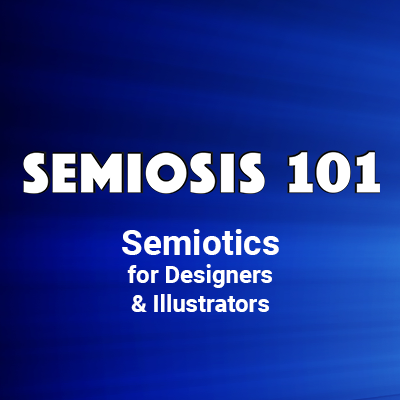Free Semiosis 101 Transcript 3.15:

PEIRCE’S TOP TEN SIGNS: Ten Classifications of Semiotic Power
Hello readers.
In this free transcript for the episode published on Semiosis 101 on Weds 21 February 2024, we discuss the mindful alignment of semiotic thinking with ideation to aid the creative to work smarter, and not ‘louder,’ structured by Peirce’s 10 semiotic sign classes.
Watch the free episode on YouTube for the full impact…
…and here is the episode’s transcript.
Early in season one I introduced Peirce’s ten sign classifications over two episodes. Check out episodes 1.7 and 1.8. These episodes could only set the scene, and I promised I would eventually come back to the subject. Well, here we are at last.
The previous 14 episodes of season three have provided enough new theoretical context to begin to explain these sign classifications. The next three episodes will deal with the “so what?” question too. Hit subscribe to this YouTube channel, and I will explain…
So what if there are ten semiotic signs, how does that help?
Quite right. Knowing how something is structured is not the same as a positive impact on how you design or illustrate. So let us begin from the impact on visual communication BACK to the theory this episode. On Semiosis 101 I have stressed semiotics is not a mechanical-engineering approach. It is not a How-To step-by-step manual. Communication is between humans… the creative and the target audience. It is qualitative not quantitative.
We have spent a lot of time across two seasons exploring how audiences interpret, and how Semiosis enhances and improves the visual communication successes. In episode 3.6 I described Peirce’s first sign-class in three words.
possible > familiar > instant
From a creative’s application point of view what benefit does that knowledge provide you as creatives
possible > familiar > instant
Whoopee-do! So what?
Yes, you are entitled to ask that question. Let me answer that quickly. But in doing so, I will build on this quick answer over the next three weeks. Graphic design and illustration has a complex job to do. To bear meaning through type, image or both beyond the denotational level. Visual communication in global 21st century societies has to work a lot harder to visually communicate above the socio-cultural visual noise. While the visual noise of competing visual outputs gets louder and louder, it is easier for people to disengage.
Instead of competing with this escalating visual noise, Semiosis offers a different tack. As Semiosis involves the audience as interpreter of what they see, the mindful alignment of semiotic thinking with ideation aids the creative to work smarter, and not ‘louder.’ This is where Peirce’s ten sign classifications can structure a smarter way to visually communicate. As I have previously summarised, we can describe the semiotic sign-action power of each sign class in three terms.
Sign One’s sign-action power can be described as… possible | familiar | instant.
Each of the remaining nine signs also can be reduced to three words. But again, “so what?” A perceptual change in a creative’s approach to designing or illustrating can be, in the long term, more productive than learning a new tool in Adobe Creative Suite software. We are talking about becoming smarter about HOW you visually communicate. Small perceptual changes in creatives can enhance your ideation, and impact on HOW you design or illustrate more effectively.
These small changes I mention obviously come from applying Semiosis. These perceptual changes via Semiosis also will impact positively on how the target audience reacts to what they see. Remember our desire while the visual noise escalates, is to offer our target audiences a quieter and more direct connection to what we are visually communicating. This brings us back to possible | familiar | instant and the ten sign classifications. Let me explain.
The first word describes… the Perception Power of the sign.
The second word describes… how the meaning is communicated.
The third word describes… the type of “vehicle” that the sign uses to carry the meaning.
In this episode we will avoid Peirce’s obtuse terminology, in favour of designer-centric terms. We will revisit his terminology next week when we discuss the “sign-vehicle” concept in more depth.
So let us now examine these 3-word descriptions. In episode 3.6 I explained these 3-word descriptions. To quickly paraphrase what I said, the first word in three explains the power the sign has to convey meaning to the audience. The second word… the power of semiotic communication used, and the third word… how the audience receives it via the “sign-vehicle” used to convey the encoded meaning. Let me now break this down in more detail to explain what these mean to designers and illustrators, so that you can begin to appreciate the semiotic sign-power you can enhance your ideation with.
First, I will outline the semiotic power the sign has to convey meaning to the audience. For regular viewers it will come as no surprise that sets of three inter-dependent levels (or triads) will feature quite heavily. So onto the first term…
Let us begin with the Perception Power of the semiotic sign. This empowers the intensity of the semiotic communication from simple to complex. Peirce illustrates his ten semiotic sign classes in an inverted pyramid. When looking at Peirce’s ten sign classes we read them in rows diagonally downwards from Sign One. In doing so we can see classes One, Two, Three, Five, Six and Eight are grouped in the top left section of the pyramid. These have a Perception Power of possible intensity of semiotic communication.
Below them are a strip of signs Four, Seven and Nine with an intensity of the suggested. Sign Ten in the top right-hand corner has an intensity of the resolved. We will return to Peirce’s terms for Semiosis 101’s designer-centric terms in the next two episodes.
Returning to Peirce’s inverted pyramid of ten semiotic sign classes, we can now outline the Communication Power of representing the concept. Now we can only see that classes One, Two, and Five are grouped in a smaller top left section of the pyramid. These each have a familiar semiotic Communication Power level. Under this power level the larger grouping is at the bottom of the pyramid, grouping signs Three, Four, Six and Seven with Communication Power of existent. A smaller grouping in the top right-hand corner of Eight, Nine and Ten have the Communication Power of proxy.
I am sensing a collective shout of “so what?” welling up in the audience but indulge me for one more minute. I am nearly there with the theoretical context to give you the “big finish.”
Finally, we can outline the semiotic Delivery Power of the effect of the sign on an interpreter. Peirce’s inverted pyramid of ten semiotic sign classes now show a different power level combination. As a quality that can be perceived as ephemerally meaning-bearing,
Sign One is the only sign class that has an instant sign-vehicle. The next sign-vehicle level is mediated and the sign classes that use this Delivery Power level are grouped together as a strip of sign classes Two, Three and Four. This means that sign classes Five to Ten are at the Delivery Power level of agreed. Peirce defines this highest Delivery Power level as “not a single Object, but a general type which, it has been agreed, shall be significant.”
Now we have mapped out the theory, let me answer the “so what?” Like with any aspect of learning to be creative, the explanation is more elongated than its actual application. So, the “so what?” question is easily answered in an equally long and short way. Let us get the short answer to the “so what?” question out of the way first.
“So what?”
Because!
There. That is the short glib answer.
Now the longer answer. To summarise in a designer-centric way, the three levels of three states each sign class is powered by, can be listed as…
Perception Power
possible, suggested, resolved
Communication Power
familiar, existent, proxy
Delivery Power
instant, mediated, agreed
Each level exists in one of the phenomenological levels of Firstness, Secondness and Thirdness. Each of the ten sign classes’ power comes from how the Perception, Communication and Delivery interact. In the next episode we will go deeper. But to end this episode let me just list the ten signs’ power in designer-centric terms.
|
ONE: |
possible > |
familiar > |
instant |
|
TWO: |
possible > |
familiar > |
mediated |
|
THREE: |
possible > |
existent > |
mediated |
|
FOUR: |
suggested > |
existent > |
mediated |
|
FIVE: |
possible > |
familiar > |
agreed |
|
SIX: |
possible > |
existent > |
agreed |
|
SEVEN: |
suggested > |
existent > |
agreed |
|
EIGHT: |
possible > |
proxy > |
agreed |
|
NINE: |
suggested > |
proxy > |
agreed |
|
TEN: |
resolved > |
proxy > |
agreed |
What the lay viewer can see from this list, beyond any initial word-soup, are combinations of how semiotic sign-action can enhance the effectiveness of visual communication. It is up to the individual creative if they wish to become more successful at visually communicating. If so, the “so what?” question is actually redundant. If not, then fine, but you will miss out on a strategy to get beyond the barrier of visual noise.
Semiosis 101 Semiotic Design Resources is a reader-supported publication. To receive exclusive posts and support my work, consider becoming a free or paid subscriber. Paid subscribers get name checked on all future Semiosis 101 YouTube episodes.
===Semiosis 101 Patreon Producer==============
Become a Semiosis 101 Patreon Producer and get a named producer credit on future video episodes, plus watch all new episodes months ahead of YouTube.
===Semiosis 101 Patreon Exclusives==============
Watch longer Patreon-exclusive Semiosis 101 episodes on applying Semiosis into design and illustration…
PATEXC001 How does semiotics work in illustration?





